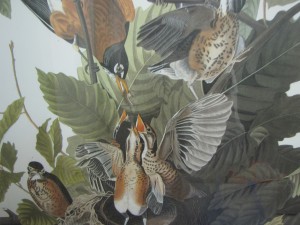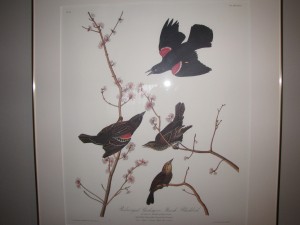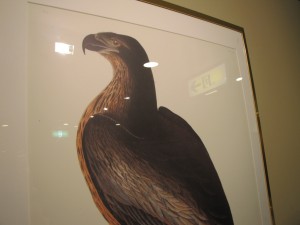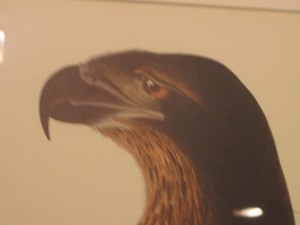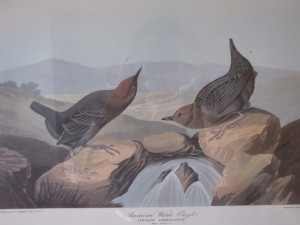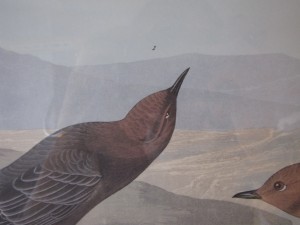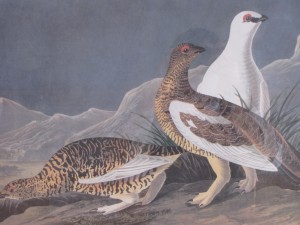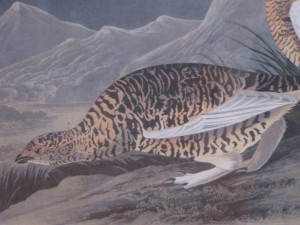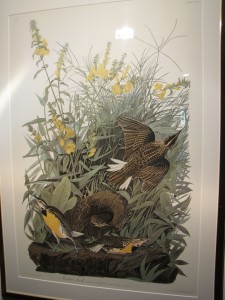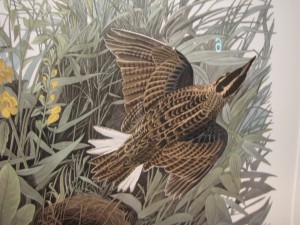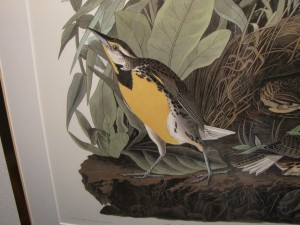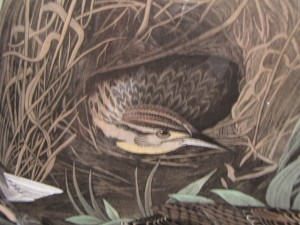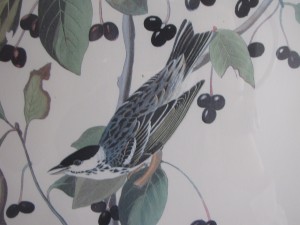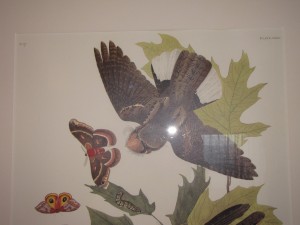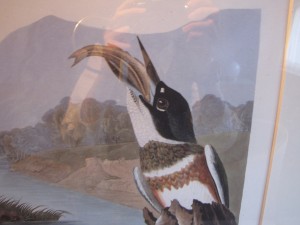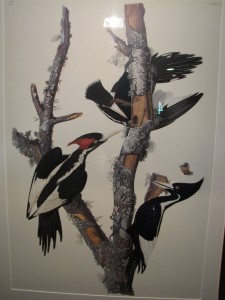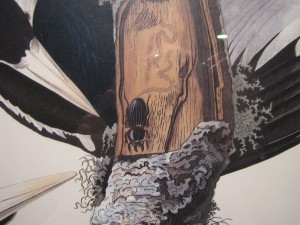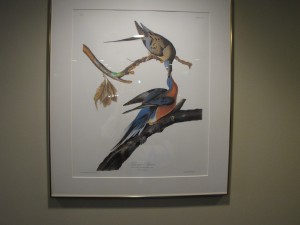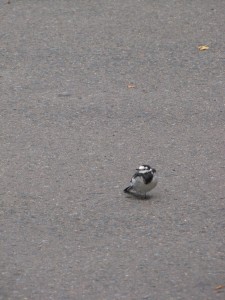2014.09.08
オーデュボンと本館 Audubon and Appi Main Building
If you`ve ever stayed in Hotel Appi Grand`s “Honkan,” or main building, before, you may have noticed the bird print hanging on your wall.
ホテル安比グランドの本館に泊まられたことがありましたら、お部屋の壁にかかっている野鳥の絵に気づいたことがあるかもしれません。
But on the other hand, who are we kidding? You very well may not have. Not many people are weird enough to immediately fixate on any bird pictures around a room. I, however, am. I noticed within a few weeks of starting work in Appi that there were a lot of bird pictures around the Honkan: at least one in every room, in every elevator hall, and even in front of the restaurants on the second floor. Not only that, but these bird pictures looked very familiar, as if I had seen them in my yard at home.
でも、まあ、気づいていないことも全然あり得ます。お部屋に入ったらすぐ野鳥の絵に注目するようなちょっと変わった人は少ないかもしれません。私はそういうちょっと変わった人間です。ホテル安比グランドに配属になって数週間したら、本館ではかなりの量の野鳥の絵がかかっていることに気づきました。客室に最低一つ、各エレベータホールに一つ、そして、1階の宴会場と2階のレストランの前に贅沢な大きい絵もありました。そして、まるでアメリカにある実家の庭で見たことがあるような野鳥ばかりでした。
And in fact, I had seen them in my yard at home. The reason for this is because the Honkan is decorated with pages from “Birds of America” by John James Audubon, published between 1827 and 1838. To give you an idea of how famous and prominent Audubon is: perhaps you`ve heard of the Wild Bird Society of Japan. The equivalent organization in the United States is called the Audubon Society.
実は、なんと本当に実家で見たことがある種類もありました。それはなぜかというと、本館は1827年~1838年まで出版されたジョン・ジェームズ・オーデュボン著の「アメリカの鳥類」という博物画集の一枚一枚で飾っているからです。オーデュボンはどれほど高名な博物学者なのかというと、日本の野鳥の会に相当する組織は「National Audubon Society」(つまり、オーデュボンの会)と呼ばれるほどなのです。
American Robin, a bird we see every spring pulling worms out of the ground. In Japan, Japanese Bush Warblers herald the spring, but in the United States that bird is the Robin.
American Robin(コマツグミ)はオレゴン州で毎年の春に地面からミミズを引っ張り出しているのがよく見られます。日本では春と言えばウグイスだそうですが、アメリカではコマツグミになっているのです。
Red-Winged Blackbird, another bird that comes to the feeder in our yard every year. The males have the bright red spots on their wings and perch everywhere, singing “I`m a Red-Winged Blaaaaackbird!”
Red-Winged Blackbird(ハゴロモガラス)も毎年、実家のエサ台に来ます。羽に鮮やかな赤いのが見えるのはオスで、至るところでとまって、「I`m a Red-Winged Blaaaackbird!」に聞こえる鳴き声でメスを呼びます。
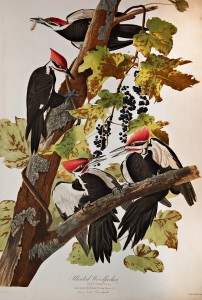
Pileated Woodpecker, an American woodpecker which pretty closely resembles the Black Woodpecker living in Hokkaido. I wanted to see this bird for years, and my dad kept coming home telling me “I saw another Pileated,” but they never came out when we went to see one together. Finally I saw one pecking at a dead snag on a birding trip.
北海道に生息するクマゲラに似ているアメリカのキツツキ、Pileated Woodpecker (カンムリキツツキ)です。私はずっとカンムリキツツキを見たかったのですが父が何回も帰ってきて「今回またカンムリキツツキを見たよ!」というのに、一緒にバードウオッチングに行くと現れてくれなくて、惜しい思いをしました。やっと、枯れ木をつついているのを数年前に見ました。
A really special individual designed Appi—the structure and color of its buildings and interior, the logos including everyone`s favorite the Appi bunny, even the lighting scheme. His name was Yusaku Kamekura, the same person who designed the posters and logo for the Tokyo Olympics. According to the book about Appi and Kamekura, Kamekura actually decided to use Audubon prints for decoration throughout the Honkan building not just because they were beautiful and fit beautifully with the color scheme, but also because paying for individual works of art with that level of detail and beauty would have been a lot more expensive.
特別な人物が安比をデザインしました:ビルの構造と色彩設計、好かれている安比のウサギも含めてすべてのロゴから照明設計まで。名前は亀倉雄策さんで、東京オリンピックのロゴとポスターを制作したデザイナーです。安比と亀倉さんについての本によると、亀倉さんがオーデュボンの絵を選んだのは、とても綺麗で本館の色と雰囲気に合っているからだけではなく、そこまで細かくて素敵な絵を一個一個ずつ買うよりオーデュボンの博物画集でホテルを飾った方がはるかに高いかららしいです。
According to some of the staff members, initially the hotel side was kind of mystified about the bird theme and may have voiced objections about it. I imagine this exchange as being like “Dear Mr. Kamekura, are you sure about this bird thing? By `birds,` did you actually mean `flowers?` How about bowls of fruit instead? Awaiting your response.”
職場の上司によると、ホテル側は最初に野鳥のテーマに疑問があったらしいです。この対話を想像してみるとこうなります:「亀倉様へ、野鳥の件なんですが、「野鳥」というのは「お花」のことでしたでしょうか?果物の入っているボウルの絵はいかがでしょうか?お返事をお待ちしております。」
The pictures themselves are gorgeous. Audubon painted all of his subjects true to size, which you should keep in mind while looking at the enormous eagle on the first floor, in front of Ryugamori.
絵自体はとても綺麗です。1階、2階とエレベータ前の絵は原作と同じサイズになると思いますが、オーデュボンが野鳥をすべて実際の大きさ通りに描いたと思うと、一階の竜ヶ森前のワシの巨大さに驚くはずです。
While you`re looking at that eagle, take a close look at his expression. That is one depressed looking eagle! What happened to him? Did his girlfriend dump him?
ちなみに、例のワシの表情をよく見てみると、かなり落ち込んでいるワシだと分かります。 このワシ、いったい何があったのでしょうか! 彼女にふられたのでしょうか?
Many other pictures have pretty expressive birds. Look closely when you get the chance.
表情が豊かな野鳥の絵が多いです。今度よく見てみて下さい。
“Hmmm….” “What? Whatcha looking at? Everything OK?”
「あのね…」「なになになに?何見ているの?どうしたん?」
“Here comes Clyde. God, I hate that guy.”
「あ~、クライドが来てしまったんだよ。いやなヤツだなあ。」
One of my favorites is this picture on the 6th floor elevator hall. I thought these were Western Meadowlarks, which happens to be the state bird of Oregon, where I am from, but it turns out they`re Eastern Meadowlarks. Apparently the white area under the beak is larger for Eastern Meadowlarks.
Anyway, Eastern or Western Meadowlark aside, I love this picture. Let`s take a look at them individually.
中で一番好きなのは、6階のエレベータホールにある絵です。前からずっと出身のオレゴン州の州鳥になる西アメリカマキバドリ(Western Meadowlark)だと思ってきましたが、実は東アメリカマキバドリ(Eastern Meadowlark)だったみたいです。東アメリカマキバドリはくちばしの近くに白っぽい部分は西のより少し大きいらしいです。
とりあえず、マキバドリの種類を別にして、この絵が大好きです。一羽ずつもっと詳しく見てみましょう。
One is diving toward the upper right corner of the frame. “Excuse me for a second! There is something urgent I need to do up here!”
一羽は、なぜか右上の隅に飛び込んでいます。「ちょっと失礼します!右上で急用がございまして!」
Another one is doing a funky shuffle dance. “Doop be doo! I`m an individual! I`m my own Meadowlark! Look at me! Dance!”
もう一羽はかなりファンキーなダンス中です。「ヤホー!個性のある自由の身のマキバドリだよ!僕を見てくれ!ダンスだ!」
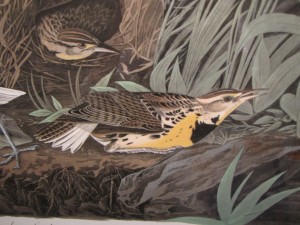 A third one is like “Mr. Audubon, you`re still not finished? For real?? OK, I`m really tired, so just let me relax a minute.”
A third one is like “Mr. Audubon, you`re still not finished? For real?? OK, I`m really tired, so just let me relax a minute.”
3羽目は「オーデュボンさんよ、絵はまだですか?…マジでですか? オケー、疲れましたからちょっとポーズを崩させて下さい。」
This last one is why this picture is my favorite in the first place. It`s just something about the female rolling her little eyes at you in this nest.
“Please go away. This is my nest.”
最後の一羽に気づいた時からこの絵を特に好きなようになりました。なんだか巣の中のメスが小さい目をぎょろぎょろさせているのが面白いです。
「私の巣です。あっち行って下さい。」
Audubon painted the birds being active in their natural surroundings, which was apparently unusual for the time. So when you look at the picture, note that the birds aren`t painted in isolation, but are surrounded with certain plants. Many are shown eating something, so you can get information about the birds` diets as well.
当時はとても珍しく、オーデュボンは野鳥を生息環境の中に描きました。なので、絵を見る時には、野鳥だけではなく、特定の植物などに囲まれていることに注意して下さい。多くの場合は、エサは何なのかと分かるように、何かを食べている鳥も描かれています。
Blackpoll Warbler(ズグロアメリカムシクイ)
Eastern whip-poor-will and moth (ホイップアーウィルヨタカとガ)
Belted Kingfisher and fish (アメリカヤマセミと魚)
Ivory Billed Woodpeckers and bug(ハシジロキツツキと虫)
Bug: “Something tells me this place isn`t safe, but I just can`t put my finger on it.”
虫「なんかここは危ない気がするけど、なんだろうね?」
There are a few interesting consequences of these prints having been published more than 150 years ago. The names of some species have of course changed in the meantime, which meant that when I guessed “Crested Caracara” but the picture was labeled “Brasilian Caracara Eagle,” I was still right, because the modern name is Crested Caracara. Unfortunately, in many (in most) cases when I guess a species wrong, it still means that I am wrong.
この博物画集は150年以上前に描かれたことによってある影響があります。種名が150年間で変わってきたのもありまして、例えばある野鳥を「Crested Caracara」だと当ててみたら、絵に「Brasilian Caracara Eagle」が書いてあっても、現在の種名はCrested Caracaraですから私の正解だったということです。しかし残念ながら、多く(ほとんど)の場合は、種名を間違えたら、私が間違っていたということになってしまいます。
Also, in the span of 150 years, some of these species have unfortunately gone extinct.
150年間で、絶滅したしまった種類もあります。
The Ivory Billed Woodpeckers in one of the elevator halls are presumed extinct, though there have been reports of the bird being alive for years. It`s still a very hotly contested topic in the birding world, but for simplification purposes let`s just call them “extinct.”
エレベータホールのかかっているハシジロキツツキは前から絶滅したと推測されていますが、まだどこかに生息しているという情報も昔からぽつぽつ入っていきています。これからも激しい論戦になりそうですが、恐らく絶滅したということにしましょう。
The Passenger Pigeon, once the most common bird in the United States went extinct from overhunting and loss of habitat. The last bird died in a zoo in 1914. This picture is on the second floor, near Bar Po and the smoking area. The “kissing” pose is actually a mating ritual.
かつてアメリカでもっとも数多くいた鳥のリョコウバトは生息地の破壊と乱獲によって絶滅しました。最後の一羽は、1914年に動物園で亡くなりました。この絵は2階のBar Poの近くにかかっています。 絵の「キス」みたいな姿勢は繁殖行動だそうです。
Next time you come to stay in Hotel Appi Grand, or just happen to be in the Honkan, make sure to take a closer look at the bird pictures.
かなり長くなったしまった記事ですが、ぜひ今回ホテル安比グランドに泊まる時、または訪れる時に、ぜひオーデュボンの絵をご覧になって下さいませ。
In terms of real, live native Japanese birds, you can also say hi to the White Wagtail who catches bugs at the entrance of Hotel Appi Grand and sometimes tries to sneak into the building.
そして、安比でたくさんの日本の実物の野鳥もご覧になれます。ホテル安比グランドの玄関で虫をとったり、たまにホテルに入り込もうとしたりするハクセキレイはその一羽です。
“Excuse me, I have a reservation for one White Wagtail, two nights?”
“No, I`m sorry, we do not accept Wagtails as customers.”
「すいませんが、予約をしましたハクセキレイ、一羽、2泊です。」
「申し訳ございませんが、セキレイのお客様をお断りしております。」
This has been Anna working at Hotel Appi Grand front division.
HAGフロントのアンナでした。
| 月 | 火 | 水 | 木 | 金 | 土 | 日 |
|---|---|---|---|---|---|---|
| « 7月 | ||||||
| 1 | 2 | 3 | 4 | 5 | 6 | |
| 7 | 8 | 9 | 10 | 11 | 12 | 13 |
| 14 | 15 | 16 | 17 | 18 | 19 | 20 |
| 21 | 22 | 23 | 24 | 25 | 26 | 27 |
| 28 | 29 | 30 | 31 | |||
ブログ内検索
最近の記事
- 2019.07.28
夏休み【期間限定】とんぼ玉販売会のお知らせ - 2019.07.04
7月週末の安比高原のイベント・アクティビティのお知らせ - 2019.07.04
8月3日よりグランピングサイトが追加になります! - 2019.06.14
【新登場!】ミニ四駆コース、テレビゲームプレイコーナー、オープンのお知らせ - 2019.05.31
6/1より、2019-2020早割シーズン券の販売を開始いたします!! - 2019.04.29
安比高原に恐竜たちが蘇る!? - 2019.04.28
GWダンスショー開催のお知らせ - 2019.04.27
ゴールデンウィークとんぼ玉販売会のお知らせ - 2019.04.20
4/27~5/6期間限定 バーベキューガーデンオープン! - 2019.04.19
安比高原 雪融け白樺樹液
過去の記事
- 2019年7月
- 2019年6月
- 2019年5月
- 2019年4月
- 2019年3月
- 2019年2月
- 2019年1月
- 2018年12月
- 2018年11月
- 2018年10月
- 2018年9月
- 2018年8月
- 2018年7月
- 2018年6月
- 2018年5月
- 2018年4月
- 2018年3月
- 2018年2月
- 2018年1月
- 2017年12月
- 2017年11月
- 2017年10月
- 2017年9月
- 2017年8月
- 2017年7月
- 2017年6月
- 2017年5月
- 2017年4月
- 2017年3月
- 2017年2月
- 2017年1月
- 2016年12月
- 2016年11月
- 2016年10月
- 2016年9月
- 2016年8月
- 2016年7月
- 2016年6月
- 2016年5月
- 2016年4月
- 2016年3月
- 2016年2月
- 2016年1月
- 2015年12月
- 2015年11月
- 2015年10月
- 2015年9月
- 2015年8月
- 2015年7月
- 2015年6月
- 2015年5月
- 2015年4月
- 2015年3月
- 2015年2月
- 2015年1月
- 2014年12月
- 2014年11月
- 2014年10月
- 2014年9月
- 2014年8月
- 2014年7月
- 2014年6月
- 2014年5月
- 2014年4月
